4.3 Sending Calendar Items
4.3.1 Understanding Calendar Items
You can schedule appointments and reminder notes for yourself and other users. You can also reserve a block of time by using a posted appointment.
For information about how appointments and reminder notes differ from other item types, see Section 1.8, Understanding GroupWise Item Types.
If you want to find out if someone is coming to your meeting, you can check for an accepted or declined status in the item’s Properties. For more information, see Working with Sent Items.
All scheduled items can be retracted or rescheduled, even if the recipients have already opened and accepted them. For more information, see Rescheduling an Appointment.
For more information about managing items after they have been sent or received, see Section 3.1, Sending E-Mail and Section 3.3, Receiving E-Mail.
4.3.2 Scheduling Appointments
Use appointments to schedule blocks of time on a specific date or range of dates.
You can use Busy Search to check for a time when all the users and resources you want for an appointment are available.
When you perform a Busy Search for users who are in a different time zone that you, GroupWise takes into consideration the difference in time zones. For example, if you are trying to schedule a meeting with a co-worker whose time zone is seven hours later than your own, that co-worker’s workday is blocked out in the Busy Search sometime after 10:00 a.m. your time.
When you schedule an appointment and include yourself as a participant, GroupWise automatically accepts the appointment for you.
Scheduling an Appointment for Yourself
If you are not available for meetings, schedule a posted appointment for those times. When another user includes you in an appointment and does a busy search, the user can see that you are not available at those times, but can still schedule over your appointment.
Posted appointments are placed in your Calendar on the date you specify. They are not placed in your Mailbox or in any other user’s Mailbox. Similarly, all posted appointments are saved to your main GroupWise calendar. To move them to a personal calendar, drag and drop them to the personal calendar after they are created.
-
On the toolbar, click the arrow on the
 button, then click .
button, then click .
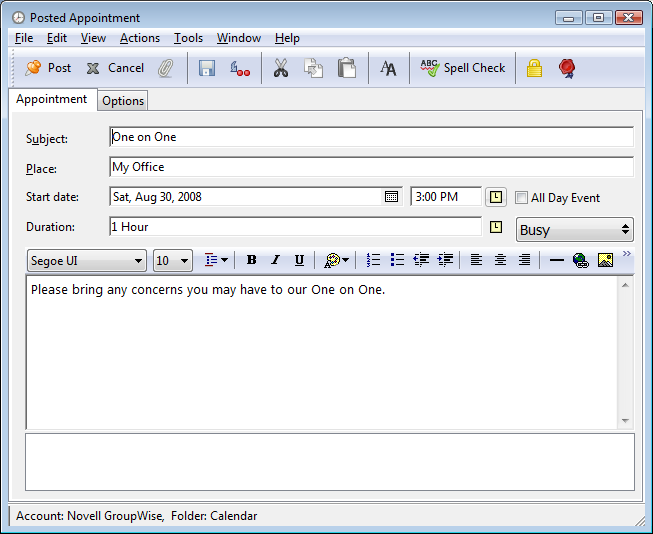
or
In your Calendar, open a view with an Appointments List, click a date, then double-click a time in that day.
-
(Optional) Type a subject and a place.
-
Specify the start date.
or
Click
 to specify a date or auto-date for your appointment. To create a recurring appointment, see Section 4.3.4, Scheduling Recurring Items.
to specify a date or auto-date for your appointment. To create a recurring appointment, see Section 4.3.4, Scheduling Recurring Items.
or
Select for an all day event.
For more information about all day events, see Understanding All Day Events.
-
Specify a start time and duration. Duration can be in minutes, hours, or days.
-
Specify how you want the appointment to appear with the drop-down menu. Appointments can appear as , , , or .
-
(Optional) Type a message.
You can specify many options, such as making this appointment a high priority and more, by clicking the tab.
-
(Optional) Specify a Show Appointment As type by clicking > , then clicking a type.
-
Click on the toolbar.
Scheduling an Appointment for Multiple People
-
Click
 on the toolbar.
on the toolbar.
-
In the field, type a username, then press Enter. Repeat for additional users. Include any resource IDs (such as conference rooms) in the field. If necessary, type usernames in the and fields.
or
To select usernames or resources from a list, click on the toolbar, double-click each user, then click .
Your name is automatically added to the field of the appointment. When you send the appointment, it is automatically added to your calendar. If you do not want to be included in the message, delete your name from the field.
-
To change the From name (to another account or proxy), click
 , then click a name.
, then click a name.
-
Type the place description in the field.
-
Specify the start date.
or
Click
 to specify a date or auto-date for your appointment. To create a recurring appointment, see Section 4.3.4, Scheduling Recurring Items.
to specify a date or auto-date for your appointment. To create a recurring appointment, see Section 4.3.4, Scheduling Recurring Items.
or
Select for an all day event.
For more information about all day events, see Understanding All Day Events.
-
Specify a start time and duration. Duration can be in minutes, hours, or days.
-
Specify how you want the appointment to appear as. Appointments can appear as , , , or .
Recipients in the and fields receive the appointment as Free.
-
Type a subject and message.
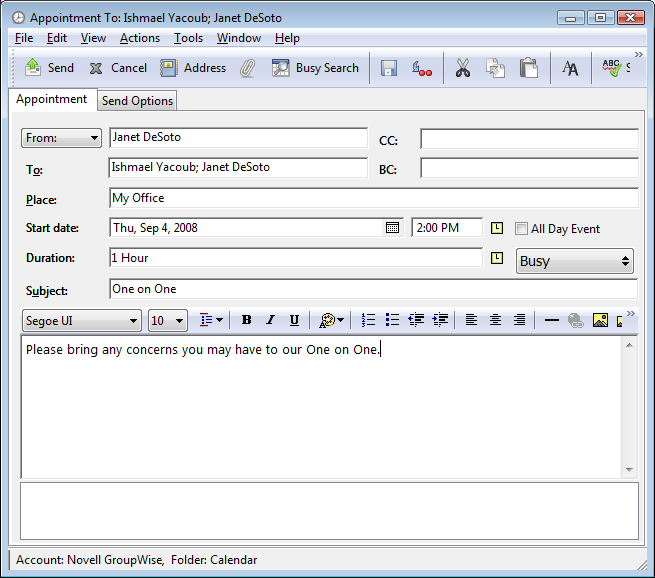
-
If you want to make sure the people and resources for the appointment are available, you can do a busy search by clicking on the toolbar. For more information, see Using Busy Search to Check Availability.
You can specify many options, such as making this appointment a high priority, requesting a reply from recipients, and more, by clicking the tab.
-
Click on the toolbar.
Using Busy Search to Check Availability
Use Busy Search to find a time when all the people and resources you want to schedule for a meeting are available.
Performing a Busy Search
-
In an appointment you are creating, specify usernames and resource IDs in the field.
-
Specify the first possible day for the meeting in the field.
-
Specify the meeting’s duration.
-
Click on the toolbar.
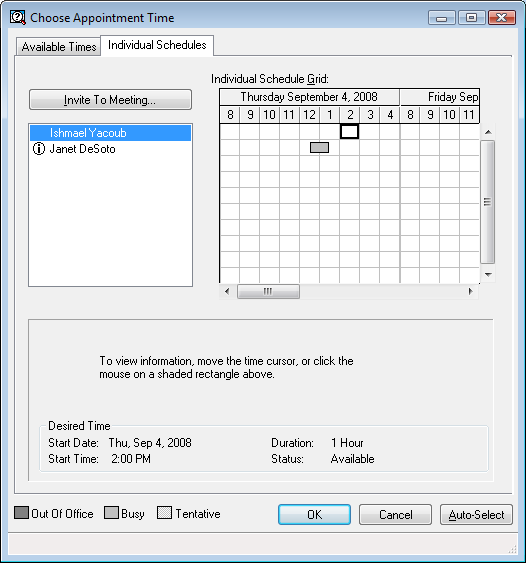
The legend at the bottom of the Busy Search dialog box shows the meaning of the various Show Appointment As patterns on the grid.
If
 appears to the left of the username or resource, you can click a scheduled time across from the username or resource on the tab to display more information about the appointment in the box below. However, the user or resource owner must give you appointment Read rights in their Access List before the
appears to the left of the username or resource, you can click a scheduled time across from the username or resource on the tab to display more information about the appointment in the box below. However, the user or resource owner must give you appointment Read rights in their Access List before the  icon appears. See Granting Proxy Rights as a Mailbox Owner.
icon appears. See Granting Proxy Rights as a Mailbox Owner.
To exclude a username or resource from the search without deleting it, click the tab, then click the check box next to the user or resource to deselect it. Excluding a person or resource from the search is useful if a user (like a CC recipient) should be invited to a meeting but does not necessarily need to attend. To include a user or resource name that has been excluded, click the check box next to the user or resource to select it.
-
Click to select the first available meeting time, then click to transfer the users, resources, and selected time and duration back to the appointment you were scheduling.
or
Click until the time you want is displayed, then click to transfer the users, resources, and selected time and duration back to the appointment you were scheduling.
or
Click the tab to see possible meeting times, click a time to select it, then click to transfer the users, resources, and selected time and duration back to the appointment you were scheduling.
-
To remove a user or resource from the list after the search, click the tab, click the username or resource to remove, press , then click .
This is useful if you want to include several conference rooms in the search to find one that is available, then eliminate those you do not want.
-
Complete and send the appointment.
If you want to do a busy search before creating an appointment, click > . Specify information in the Busy Search dialog box, then click to perform a busy search. When you find a time you want for a meeting, click to transfer the information to a new appointment view, then complete the appointment.
You can change the search range for one appointment by scheduling the appointment with > and changing the number in the .
This method is useful when you are scheduling recurring appointments or planning appointments that may be further in the future.
Changing Busy Search Options
You can change the search range, time, and days default for all appointments on the tab in Date Time Options.
-
Click > , double-click , then click the tab.
-
Change the options you want.
Options include the range of dates or specific days to search.
-
Click .
Understanding All Day Events
When you are creating a GroupWise appointment, you can choose to make the appointment an all day event by selecting , located next to the time input field.
You can specify how you want the appointment to appear by clicking the availability button, located below the select box. Appointments can appear as , , , or . Unlike regular appointments, by default, all recipients receive all day event appointments as Free. This is because all day events are often intended to be strictly informational for recipients. For example, you might send out an all day event to inform colleagues that you are going to be on vacation. In this case, colleagues who receive the event are not shown as Busy on the day of the event.
Time Input
When you schedule appointments and other items you might be required to specify a time. In most cases you have the option to specify the time by typing it directly into the time field or entering it through the time input field. Click  to open the time input window.
to open the time input window.
Figure 4-7 Time Input Window
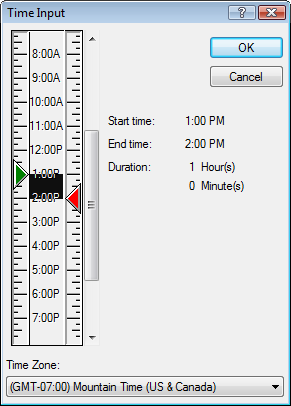
Use the green arrow to select a start time and the red arrow to select an end time. The currently selected times display on the right side of the screen. You can use intervals as small as 15 minutes.
If a correct time has already been entered, you can it by dragging the selected area up or down.
A time zone option is available to specify a specific time zone for the event. For more information on time zones, see Specifying a Time Zone for an Appointment.
Specifying a Time Zone for an Appointment
The Time Zone feature lets you schedule a meeting for recipients in different time zones who will meet in a single location.
Normally, GroupWise automatically adjusts meeting times based on the recipients’ time zones. For example, a meeting scheduled by a user in Utah for 10:00 would be displayed as 9:00 for a recipient in California and as 12:00 for a user in New York because these users are in different time zones. Because GroupWise adjusts the time, all the users scheduled for a conference call can call in at the same moment, even though their local time might differ.
Use the Time Zone feature if you don’t want GroupWise to adjust to the recipients’ local time zone. For example, if you are in the Saskatchewan time zone and include users from the Mountain Time (US & Canada) time zone in your appointment, you would use the Time Zone feature if these users are flying to Saskatchewan for the appointment. Time Zone ensures that the appointment in their Calendars and Mailboxes shows the correct Saskatchewan time.
-
Open and create a new appointment.
-
Click > , click the drop-down list and select the time zone for the appointment location, then click .
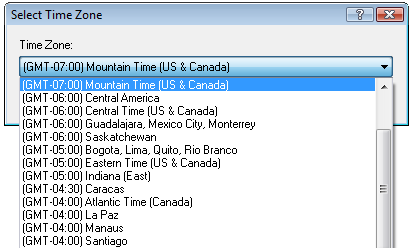
-
Click on the toolbar.
When the users you have scheduled with the Time Zone feature receive the appointment, they see a time annotation after the subject when they see the appointment in their Mailboxes. For example, if the subject of the meeting is “Marketing Conference” and the time zone is Saskatchewan, users would see a subject and time annotation similar to the following: Marketing Conference (Saskatchewan). In the users’ Calendars, the place is annotated with the time zone, rather than the subject.
Rescheduling an Appointment
If you want to make sure the people and resources for the appointment are available, you can do a busy search by clicking on the toolbar.
-
In your calendar, right-click the appointment you want to reschedule, then click .
If you are rescheduling just one appointment in a series of recurring appointments, select the appointment on the day you want to reschedule.
-
If the original appointment was an auto-date appointment, click or .
-
Make your changes, then click on the toolbar.
-
Click to retract the original item.
To reschedule an appointment for a new time on the same day, open your Calendar and drag the appointment to the new time.
Rescheduling Recurring Appointments
-
In your calendar, right-click the appointment you want to reschedule, then click .
If you are rescheduling just one appointment in a series of recurring appointments, select the appointment on the day you want to reschedule.
-
Click for all appointments in the recurring appointment.
or
Click for only one appointment in the series of recurring appointments.
-
Make your changes, then click on the toolbar.
-
Click to retract the original item.
To reschedule an appointment for a new time on the same day, open your Calendar and drag the appointment to the new time.
Canceling an Appointment
You can cancel an appointment if you scheduled it or if you have the necessary Proxy rights to the scheduler’s Mailbox.
-
In your calendar, right-click the appointment you want to cancel, then click .
-
Select to remove it from other users’ mailboxes. Leave this option deselected if you want to delete it only from your own mailbox.
-
(Optional) Type a message explaining the cancellation.
-
Then click .
A Meeting Cancelled message is sent to each user that the appointment was sent to, and the appointment is removed from the user’s calendar. Users who had the appointment delegated to them do not receive a Meeting Cancelled message, but the appointment is removed from their calendars.
Canceling a Recurring Appointment
You can cancel a recurring appointment if you scheduled it or if you have the necessary Proxy rights to the scheduler’s Mailbox.
-
In your calendar, right-click the recurring appointment you want to cancel, then click .
-
Select .
-
(Optional) Type a message explaining the cancellation.
-
Click .
-
Click , , or .
A Meeting Cancelled message is sent to each user that the appointment was sent to, and the appointment is removed from the user’s calendar. Users who had the appointment delegated to them do not receive a Meeting Cancelled message, but the appointment is removed from their calendar.
Modifying Recipients
-
Open your Sent Items folder.
-
Find the appointment you want to modify.
-
Right-click the appointment and select .
-
Specify your new recipients in the , , and fields.
-
Click .
4.3.3 Sending Reminder Notes
Reminder notes are like mail messages except they are scheduled for a particular day and appear on the Calendar for that date. You can use reminder notes to show vacations, holidays, paydays, birthdays, and so forth.
Scheduling a Reminder Note for Yourself
A reminder note to yourself is called a posted reminder note. Posted reminder notes are placed in your Calendar on the date you specify. They are not placed in your Mailbox or in any other user’s Mailbox.
-
From your Calendar, open a view with a Reminder Notes List (for example, the Week view).
-
Click a date, then double-click an empty space in the Reminder Notes List.
-
If necessary, click
 to specify a start date or auto-date for your reminder note.
to specify a start date or auto-date for your reminder note.
-
Type a subject and the reminder note message.
You can specify many options, such as making this reminder note a high priority and more, by clicking the tab.
-
Click on the toolbar.
To access the information later, open your Calendar and select the date the information appears on. Double-click the reminder note in the Reminder Notes List.
Scheduling a Reminder Note for Others
-
Click > > .
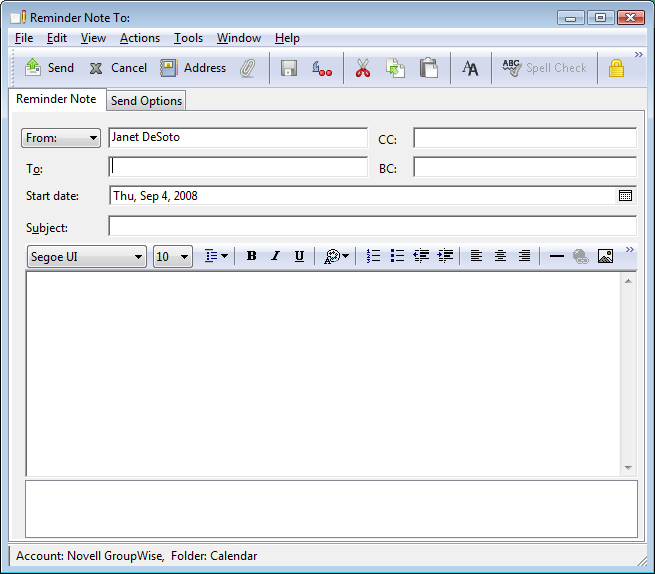
-
In the field, type a username, then press Enter. Repeat for additional users. If necessary, type usernames in the and fields.
or
To select usernames from a list, click on the toolbar, double-click each user, then click .
-
To change the From name (to another account or proxy), click
 , then click a name.
, then click a name.
-
(Optional) Type a subject and the reminder note message.
-
In the field, type the date this reminder note should appear in the recipients’ Calendars.
or
Click
 to specify a start date or auto-date for your reminder note.
to specify a start date or auto-date for your reminder note.
You can specify many options, such as making this reminder note a high priority, requesting a reply from recipients, and more, by clicking the tab.
-
Click on the toolbar.
4.3.4 Scheduling Recurring Items
Use Auto-Date to schedule recurring appointments, tasks, and reminder notes.
Auto-Dates can occur on the same day every week (for example, every Monday), the same days of the month (for example, the 15th and last day), or any other defined series of dates. You can also use Auto-Date to schedule irregular or infrequent events, such as holidays.
When you send an Auto-Date item, GroupWise copies the item and places one of the defined dates in each copy of the item. For example, if you define five dates for the event, GroupWise makes five copies of the item and schedules one copy for each date. If you send the item to other users, you have five outgoing items with a five-occurrence Auto-Date. If you receive the event, you find five copies of the incoming item in your Mailbox, each scheduled for a different date.
You can create an Auto-Date in three ways.
-
lets you select specific days from a year calendar.
-
lets you schedule events on the same day every week, the same day each month, or periodically.
-
lets you enter the scheduling information in text format.
This section contains the following topics:
Scheduling a Recurring Item by Dates
-
In an appointment, task, or reminder note you are scheduling, click , then click .
-
Click the days you want to schedule.
-
To move to a different year, click the year button, type the new year, then click .
-
If you want to clear all the dates you have selected, click .
-
Click .
Scheduling a Recurring Item by Example
-
In an appointment, task, or reminder note you are scheduling, click > .
-
Click the tab.
-
In the group box, specify the starting date and ending date.
or
To specify a certain number of occurrences rather than a range, specify the starting date, click the drop-down list, click , then specify the number of occurrences.
-
Click the drop-down list, then click an option.
-
Click the months to schedule. To schedule all of the months, double-click any month.
-
If you clicked , click an option from the drop-down list, then click the numbered days you want to schedule (for example, 1 and 15).
or
If you clicked , click the ordinal number across from the day of the week to schedule (for example, 2nd Tue).
or
If you clicked , specify a period length (for example, Recur Every 15 Days).
-
If you want to clear the dates you have selected, click .
-
To verify that you scheduled the correct dates, click the tab. The dates you scheduled in the tab are selected in the calendars. If you want to deselect any occurrence, click the days you want to deselect on the tab.
-
Click .
Scheduling a Recurring Item Based on Another Day of the Week
You can schedule recurring items for events that occur a specified number of days prior to or after a specified day of the week. For example, you could schedule a meeting on the Monday following the first Sunday of each month (which might or might not be the first Monday of the month).
-
In an appointment, task, or reminder note you are scheduling, click > .
-
Click the tab.
-
In the group box, specify the starting date and ending date.
-
Click the months you want to include. To include all months, double-click any month in the group box.
-
Click one or more ordinal numbers in the row across from the day of the week you want to base your scheduling on (for example, 1st in the Sun row).
-
Click a day of the week (for example, Sun).
-
Specify the number of days to offset (for example, 1), then click OK.
-
To verify the dates you have scheduled, click the tab and check the dates selected in the calendar.
-
Click .
Scheduling a Recurring Item Based on the Last Day of the Month
You can schedule recurring items for events that occur a specified number of days before or after the last day of the month. For example, if you want a reminder note to appear in your Reminder Notes List on the second-to-last day of each month, type -1 in Step 8 below.
-
In an appointment, task, or reminder note you are scheduling, click > .
-
Click the tab.
-
In the group box, specify the starting date and ending date.
-
Click the months you want to include.
To include all months, double-click any month in the group box.
-
Click the pop-up list, then click .
-
Click one or more days of the week (for example, Mon, Wed, and Fri).
To include all days, double-click any day in the group box.
-
Click , then click the button.
-
Specify the number of days to offset, then click twice.
-
To verify the dates you have scheduled, click the tab and check the dates selected in the calendar.
-
Click .
Scheduling Auto-Dates by Formula
You can use a formula to schedule items for events that occur on the same day each week (for example, every Monday), the same day each month (for example, the 15th and last day), the same day of the year each year (for example, June 20), or in a defined period of time (for example, every 14 days). However, you can accomplish the same type of scheduling more easily using the or tabs. Use formulas only if you are comfortable working with them.
-
In an appointment, task, or reminder note you are scheduling, click > .
-
Click the tab.
-
In the group box, specify the starting date and ending date.
or
To specify a certain number of occurrences rather than a range, specify the starting date, click in the drop-down list, then specify the number of occurrences.
-
Type the formula text.
-
If you want to clear the Auto-Date dialog box, click .
-
To verify that you have scheduled the correct days, click the tab. The days you scheduled are selected in the calendar. If you want to deselect any occurrence, click the day you want to deselect on the tab.
-
Click .
If you want the item to be scheduled annually, just type the month and date in the formula text field (for example June 20). An annual appointment is helpful for reminder items like birthday reminders. You can also set a birthday or anniversary reminder through the Contacts folder. For more information, see Adding a Contact.
You can schedule auto-dated items by formula, dates, or example. Formulas should only be used if you prefer them; scheduling is much easier by dates or example.
Auto-Date Formula Functions
Use the auto-date functions listed below to schedule specific days of a week, month, or year. You must use the exact spelling of the functions. For example, GroupWise reads “tue”, but not “tues”. GroupWise formula functions are not case-sensitive.
-
Day of the Week: For example, TUE schedules all Tuesdays.
-
Day of the Month: For example, the number 3 schedules the third day of the month. Also, the word LAST schedules the last day of the month.
-
Day of the Year: For example, 35 schedules the 35th day of the year.
-
Month of the Year: For example, JAN schedules all days in January.
-
Year: For example, 2009 schedules all days in 2009.
-
Weekday of the Month: For example, TUE(1). This schedules the first Tuesday of the month. Also, SUN(LAST) schedules the last Sunday of the month, and FRI(LAST-1) schedules the second to last Friday of the month.
Auto-Date Formula Operators
An operator is a character or word you insert in an auto-date formula to perform a specific operation. Each operator is assigned a priority, meaning that when a formula is evaluated, some operations are performed before others.
You can use grouping operators to group operators according to their priorities. The table below lists operators and their priorities. Additional details about the operators are provided following the table.
|
Function |
Priority |
|---|---|
|
A blank space (high-priority And) |
1 |
|
Plus or + |
2 |
|
Minus or - |
2 |
|
To or: |
3 |
|
Every. . .Starting |
4 |
|
Every. . .Ending |
4 |
|
Before |
5 |
|
On/Before |
5 |
|
After |
5 |
|
On/After |
5 |
|
Near |
5 |
|
Near/After |
5 |
|
Or or , |
6 |
|
Not or ! |
6 |
|
And or & (low-priority And) |
7 |
-
Grouping Operators: Use parentheses as grouping operators to change the priority of operators or to group functions together for clarification.
For example, because the high-priority And operator (a space) has a higher priority than the Or operator (a comma), the formula below means that all scheduled days must fall on a Tuesday or must fall on a Thursday and be in the month of July or must be in the month of August.
tue,thu jul,aug
In other words, the formula is performed as if parentheses were inserted as follows:
(tue,thu) (jul,aug)
Now examine the following formula:
(tue),(thu jul),(aug)
This formula schedules all Tuesdays, all Thursdays in the month of July, and all days in the months of August. Notice how the meaning changes when parentheses are included as in the formula below.
(tue,thu) (jul,aug)
With the above formula, all scheduled days must fall on a Tuesday or Thursday and must be in the month of July or August. The end result is that only Tuesdays and Thursdays in July and August are scheduled.
-
High-Priority And: A space between two functions acts as an And operator, meaning that both functions must hold true. For example, 25 means the 25th day of all months in all years. But 25 oct means that all scheduled days must fall on the 25th day of the month and must be in October. And 25 oct 2011 means that all scheduled days must fall on the 25th day of the month and must be in October and must be in the year 2011.
-
Offset Operators: You can use a positive offset operator (+ or the word PLUS) or a negative offset operator (- or the word MINUS) to add a relative offset to a function or statement.
For example, to schedule an event three days before the first Thursday in February for all years, you could enter the following formula:
thu(1) feb-3
-
Range: The range operator (: or the word To) functions like a series of Or operators (see Or:) between each item (day, month, etc.) in the range. For example, if you want to schedule the 15th of every month, but only if the 15th is a weekday, you could enter either of the following formulas:
15&mon:fri
15(mon:fri)
This formula means that all scheduled days must fall on the 15th of the month and must be a day from Monday to Friday. Another way of describing the formula is that all scheduled days must fall on the 15th of the month and must be a Monday or Tuesday or Wednesday or Thursday or Friday.
-
Periodic Operators: The three periodic operators are Every, Starting, and Ending. Use Every in combination with Starting and/or Ending to schedule days at regular intervals, beginning on a specific date and/or ending on a specific date. For example, suppose you want to schedule a meeting for once a week starting on March 3, 2011 and continuing through June 11, 2011. You could use the following formula:
every 7 starting mar 3 2011 ending jun 11 2011
The formula schedules every seventh day starting with March 3, 2011 and ending with June 11, 2011. The starting date is always scheduled as the first day and the ending date is scheduled only if it naturally falls at the Every interval.
If you do not use both the Starting and Ending operators, the starting or ending date is the first or last date in the Calendar file.
For example, examine the following formula:
every 7 starting mar 3 2011
The above formula schedules every seventh day starting on March 3, 2011 and continuing to the last date in the Calendar file. The Every command works with numbers up to 30. For example, “every 45 starting mar 3 2011” is not a valid formula.
-
Relative Operators: The six relative operators are Before, On/Before, After, On/After, Near, and On/Near. Use these operators to schedule days relative to a specific date. For example, to schedule the Monday closest to November 6 in all years, you could enter the following formula:
mon on/near nov 6
If you need to schedule the first Tuesday after November 6, 2011, you could enter the following formula:
tue after nov 6 2011
-
Or: You can use the Or operator (a comma or the word Or) to indicate that one or the other function or statement must hold true in order to schedule days.
For example, to schedule an appointment on the 15th day of each month in the year 2011, but only if the 15th falls on a Tuesday or Thursday, enter the following formula:
15 2011 (tue,thu)
-
Not: When it is placed before a function, the Not operator (! or the word Not) negates that function.
For example, if you want to schedule all days in January 2011 except for Tuesdays and Thursdays, you could use the following formula:
jan 2011 !tue !thu
-
Low-Priority And: Like a space, the low-priority And operator (& or the word And) between two functions indicates that both functions must hold true. However, the low-priority And has the lowest priority of all operators.
For example, examine the following formula:
tue,thu jul,aug
This means that scheduled days must be a Tuesday or must be a Thursday and must be in July or must be in August. However, suppose you were to substitute the high-priority And (a space) with a low-priority And, as in the following formula:
tue,thu and jul,aug
The above formula indicates that scheduled days must be a Tuesday or must be a Thursday and must be in July or must be in August. In the first formula, the And operator is evaluated before the Or operators. In the second formula, the And operator is evaluated after the Or operators.